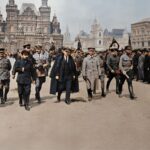The cultural sound and imagery of Bob Dylan has long eclipsed his personal identity. He has always been an elusive figure who seemingly endures fame in order to live freely and poetically through the expression of song and composition.
I became more aware of this in 2009 when I saw him perform at London’s O2 arena with his band. As the performance ended, the audience reaction seemed to be a mix of awe at his musical genius and frustration at his musical arrangements.
Some songs felt nearly as obscure as the performer himself, who blended into the band on the darkened stage. Dylan seemed less interested in being seen and more focused on the authenticity of sharing music and originality in the moment.
A joy to witness, this spontaneity is beautifully captured in James Mangold’s A Complete Unknown, who once again proves his forte for biographical drama. His 2005 film Walk the Line still holds up as an engaging chronicle of the early life and ascent to fame of Johnny Cash – and, similarly, A Complete Unknown charts a specific period of Dylan’s formative musical career.
Looking for something good? Cut through the noise with a carefully curated selection of the latest releases, live events and exhibitions, straight to your inbox every fortnight, on Fridays. Sign up here.
The young musician from Duluth, Minnesota, arrived on to New York’s folk scene in 1961, a period which ended in 1965 with the release of his album Highway 61 Revisited.
Along the way, Mangold’s film charts Dylan’s experimentation with the electric guitar and the controversy this creates as he headlines the Newport Folk Festival, where his new sound is met with vehement disapproval, dividing fans. The folk aficionados in the film, like the disgruntled O2 fans of 2009, demonstrate their frustration at Dylan failing to conform to expectations.
Timmy’s in the basement mixing up emotions
This freewheelin’ nonchalance is commendably delivered by Timothée Chalamet who brings charm, vulnerability and authenticity to what I’m sure will become one of the stand-out roles of his career. Chalamet convincingly embodies the performer in gesture, posture and sound, and sang and played all the musical performances.
But his talent is much more than this, as Mangold highlights in the press notes: “I didn’t want Timmy to disappear. It’s a performance. I wanted Timmy to bring who he is to Bob. If it becomes just a series of mannerisms and vocal impressions, there is no one really there.” Chamalet’s ability to flesh out some of the iconic and elusive figure that is Bob Dylan is testament to his range as a performer.
Chalamet’s Dylan is often lost in the songwriting process which becomes a barrier to some of the more intimate relationships in his life. Whether this is accurate or not seems irrelevant as interpretations of luminary figures are often subjective, particularly when figures are as fiercely private as Dylan.
The 29-year-old actor admits he knew little about the artist intitially, but delivers a convincing performance to carry the whole 141-minute running time. This is a huge feat when compared to Todd Haynes’s I’m Not There (2007) which ran to a little less, but used six different performers including Heath Ledger, Cate Blanchett and Richard Gere to creatively showcase the spirit of Dylan across different eras.
This process, along with the title of Haynes’s film serves to remind us of the impossibility of any one person capturing or truly knowing such an arcane figure, and how Chalamet’s blank slate (at the start of the process at least) works in his favour.
Subterranean electric blues
The film takes its cue from Elijah Wald’s 2016 book Dylan Goes Electric! Newport, Seeger, Dylan and the Night That Split the Sixties, with the civil rights movement and New York City serving as the backdrop.
The city often feels like a character itself as Dylan roves the dive bars, shabby streets and record shops of Greenwich Village, drifting in and out of relationships and experiences. His desire to meet folk hero Woody Guthrie (Scoot McNairy) is what brings him to the city before he establishes a bond with singer Peter Seeger (Edward Norton) who is initially something of a father figure.
These are stellar performances from the supporting cast, including Monica Barbaro’s rendition of America folk singer Joan Baez and Elle Fanning’s Sylvie Russo. Her character is a fictionalised version of Suze Rotolo, the American artist who was in a relationship with Dylan during the period in which the film is set (seen walking with the singer on the cover of The Freewheelin’ Bob Dylan).
Dylan requested the name change out of respect for Rotolo and the film does indicate some of the personal history of their troubled relationship, including his affair with Baez. Like Dylan’s change from folk to electric, the film does well in charting Baez and Russo’s change from adoration to frustration with the singer who is constantly travelling in body, mind and spirit along a path visible only to him.
There are some melodramatic moments within the film, and I particularly liked the way these clearly riff on Irving Rapper’s classic 1942 film Now, Voyager (starring Bette Davis), which Dylan and Russo go and watch at the cinema before reenacting the film’s iconic ending: “Don’t let’s ask for the moon, we have the stars.”
The deliberate use of such melodramatic moments reminds us of the way that Mangold’s film (at Dylan’s request) is deliberately mixing truth with fiction, which is the very essence of Bob Dylan’s persona for so many: a familiar but distant presence and a generational icon intimately unknown by most.
This is another reason why A Complete Unknown works – it is respectful to its source material and the fans, as well as being thoroughly researched and beautifully crafted. Mangold’s highly recommended film captures the ephemeral and poetic spirit of a true rolling stone.![]()
Daniel O’Brien, Lecturer, Department of Literature Film and Theatre Studies, University of Essex
This article is republished from The Conversation under a Creative Commons license. Read the original article.


























